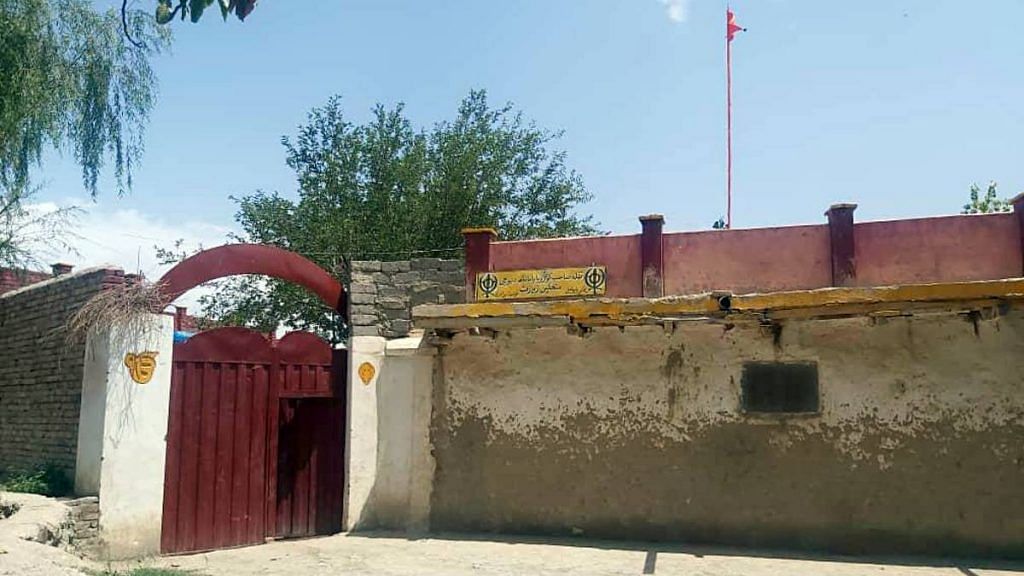New Delhi: The recent incident related to the removal of the sacred Sikh symbol ‘Nishan Sahib’ by the Taliban, from the top of a gurdwara in Afghanistan’s eastern Paktia province — it was restored after the Indian government strongly reacted to it — has brought to the fore a lesser-known aspect of Afghanistan, that the country has been a home to many historic gurdwaras across several cities as well as villages. Many of them have been lost in the civil war leading to the exit of most Hindu and Sikh families from Afghanistan. This is an important part of history, which unfortunately, is on the verge of being wiped out.
Most of these gurdwaras had historic significance and also point towards the fact that Sikhs and Hindus have had a long history of living in Afghanistan. Many had handwritten copies of the sacred texts of Sikhs — Sri Guru Granth Sahib and Dasham Granth.
One of the most authentic texts which provides information about these gurdwaras is Afghanistan Da Safar written in Punjabi by Professor Ganda Singh, who visited Afghanistan in 1952 to research on Ahmed Shah Abdali. It was published in 1954 by Prakash & Co., New Delhi.
Inderjeet Singh, an Afghani Sikh, translated excerpts of these memoirs in his seminal work Afghan Hindus and Sikhs: History of a Thousand Years (first published in 2019).
Professor Ganda Singh had visited several cities during his visit and he gave specific details about all the gurdwaras he visited. “There are seven (gurdwaras) in Kabul, five in Kandahar, and one each in Ghazni, Jalalabad and Sultanpur. There are gurudwaras in small towns and villages as well,” wrote Professor Ganda Singh.
Also read: Lost in history — role RSS played in liberation of Dadra and Nagar Haveli on this day in 1954
The gurdwaras of Afghanistan
The five gurdwaras in Kandahar were known as ‘Dharamsaal’. Professor Ganda Singh visited them on 5 September 1952, and wrote a first-hand account of what he saw. Dharamsaal Siri Guru Nanak Sahib was based in Kabuli Bazaar, Suthrian Di Dharamsaal, Waadi Dharamsaal and Chhoti Dharamsaal were in Shikarpuri Bazaar. The fifth gurdwara in Kandahar, mentioned by Professor Ganda Singh, was known as ‘Dharamsaal of Masands’.
“Waadi Dharamsaal…was famous as the Dharamsaal of Baba Siri Chand, the son of Guru Nanak and founder of Udasi sect, who visited Afghanistan. The word waadi means bigger. There was an old handwritten copy of Guru Granth Sahib which was written (in) Samvat 1725 or 1668 CE during the time of the ninth Guru, Tegh Bahadur,” writes Inderjeet Singh, quoting Professor Ganda Singh.
In Ghazni, Professor Ganda Singh visited an old gurdwara on 7 September 1952. Inderjeet Singh adds, “The gurdwara had seven old handwritten copies of the Guru Granth Sahib and one Dasham Granth. On four of the birs (Guru Granth Sahib) was written Samvat, 1811, 1814, 1821 and 1825 Bikrami (1754,1757,1764 and 1768 CE).” The second gurdwara in Ghazni was known as Gurdwara Kotla Sahib and it was situated two kilometres away on a hill outside Ghazni city.
In Jalalabad also, there was a big gurdwara sahib (Guru Nanak Darbar) under the management of Khalsa Diwan.
Professor Ganda Singh wrote that the Sikhs in Afghanistan have great respect for the religion and there was hardly anyone who missed the morning congregation at the gurdwara.
Also read: Bhagwat’s Muslim population remark isn’t surprising, RSS view on demography has evolved
Handwritten copies of Guru Granth Sahib
“Unfortunately, the oldest historical Gurudwara of Afghanistan, Gurudwara Guru Nanak, based in Jad Mewan was demolished when the road was widened in 1950,” writes Inderjeet Singh.
He further adds, “After the Gurudwara Guru Nanak…Gurudwara Khalsa (Dera Bhai Gurdas) in Shor Bazaar (in Kabul) is the oldest one. During the time of Guru Hargobind, Bhai Gurdas came here and it was built at that time”.
Another gurdwara in Shor Bazaar in Kabul was known as Gurdwara Baba Siri Chand. It was established by Baba Almast. There were two handwritten copies of Guru Granth Sahib and one of them was dated Samvat 1918 jeth 25 (or 1861 CE).
Another gurdwara in Kabul was known as Gurdwara Baba Ganj Baksh, named after Baba Ganj Baksh from Gurdaspur. The gurdwara had three handwritten copies of Guru Granth Sahib and one of them was dated 1806 Katak (1749 CE).
The Gurdwara Bhai Pirana at Saria Lahoriya is named after Bhai Pirana, a famous Sikh and a preacher during the time of Guru Arjan and Guru Hargobind, writes Inderjeet Singh. “He was both a saint and a soldier. He fought very bravely alongside Guru Hargobind in the battles against Mughals.”
Singh writes, “According to Professor Ganda Singh, there were about 6000-7000 Sikhs and Hindus in the country who lived mainly in Kabul, Kandahar, Jalalabad, Ghazni and other cities. A few of them lived in villages as well.”
He adds, “The dates on the handwritten copies of the Guru Granth Sahib are yet another proof of the antiquity of Sikhs in Afghanistan. The Professor (Ganda Singh) visited the house of one Kartar Singh, who lived in the Hindu Gujjar area of Kabul and possessed a copy of the Guru Granth Sahib which had the signature of Guru Gobind Singh.”
(The writer is a research director at RSS-linked think-tank Vichar Vinimay Kendra. Views expressed are personal.)
Also read: Why the saffron flag is revered as ‘guru’ & worshipped by RSS swayamsevaks
